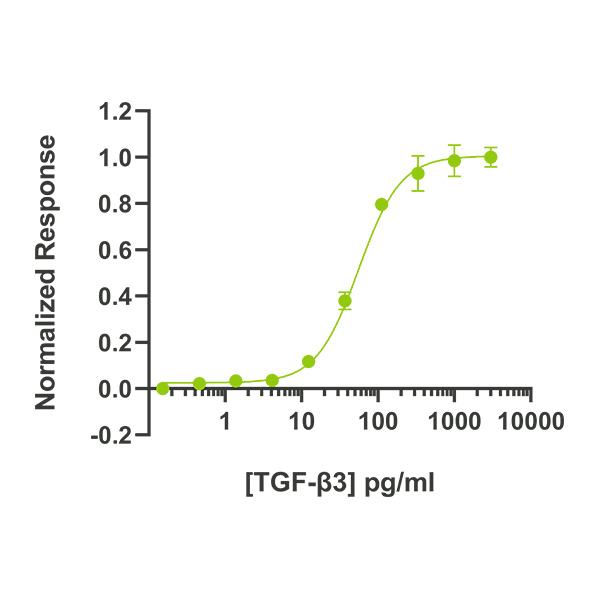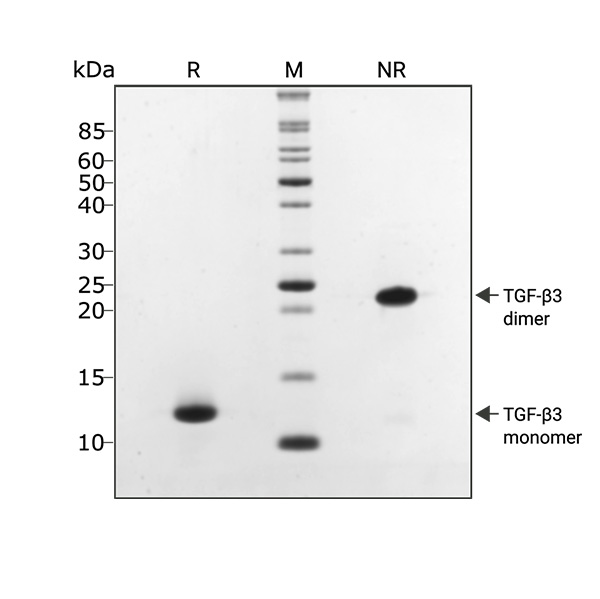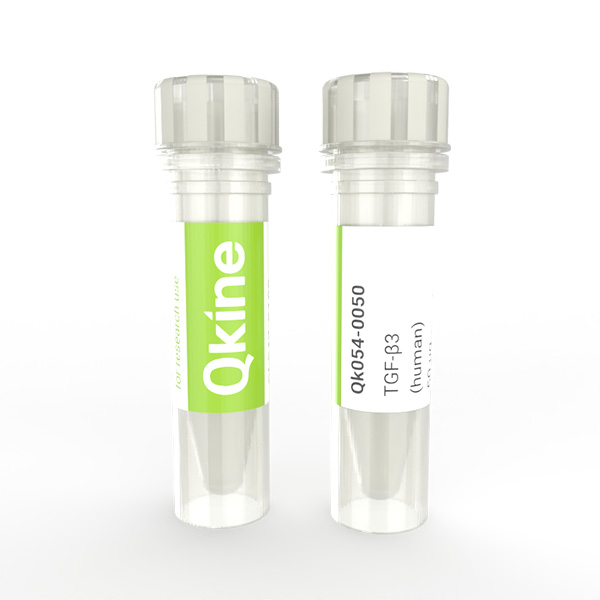Currency
Recombinant human TGF-β3 protein (Qk054)
Human transforming growth factor beta 3 (TGF-β3) protein is a member of the TGF-β family, a family involved in regulating cell survival, proliferation and differentiation. TGF-β3 is used in human pluripotent stem cell maintenance media.
Qkine TGF-β3 is a highly pure and bioactive 25.4 kDa protein dimer. Qkine growth factors are animal-origin free (AOF) and carrier-protein free (CF) for reproducible results.
Orders are typically shipped same or next day (except Friday).
Easy world-wide ordering, direct or through our distributors.
1000µg will be despatched as 2 x 500µg
Fast and free shipping.
Buy online with secure credit card or purchase order.
For any questions, please email orders@qkine.com
Summary
High purity TGF-β3 (Uniprot: P10600)
>98%, by SDS-PAGE quantitative densitometry
12.7 kDa monomer, 25.4 kDa dimer
Expressed in E. coli
Animal origin-free (AOF) and carrier protein-free
Manufactured in Cambridge, UK
Lyophilized from acetonitrile, TFA
Resuspend in 10mM HCl at >100 µg/ml (provided with protein and free of charge), prepare single use aliquots, add carrier protein if desired and store frozen at – 20°C or – 80°C
Featured applications
Human pluripotent stem cell maintenance
Mesoderm differentiation
Transforming growth factor beta-3, TGF-b3, TGFB3, prepro-transforming growth factor beta-3, arrhythmogenic right ventricular dysplasia 1 (ARVD, ARVD1)
Human
Bioactivity

TGF-β3 activity is determined using a TGF-β3 responsive firefly luciferase reporter in HEK293T cells. EC50 = 50 pg/ml. Bioactivity is determined using a TGF-β3 responsive firefly luciferase reporter in HEK293T cells. Cells are treated (in triplicate) with a serial dilution of TGF-β3 for 6 hours. Firefly luciferase activity is measured and normalised to the control Renilla luciferase activity. Data from Qk054 batch #104369.
Purity

TGF-β3 migrates as a single band at 25 kDa in non-reducing (NR) conditions and 13 kDa upon reduction (R). No contaminating protein bands are visible. Purified recombinant protein (3 µg) was resolved using 15% w/v SDS-PAGE in reduced (+β-mercaptothanol, R) and non-reduced (NR) conditions and stained with Coomassie Brilliant Blue R250. Data from Qk054 batch #104369.
Further quality assays
Mass spectrometry: single species with expected mass
Endotoxin: <0.005 EU/μg protein (below level of detection)
Recovery from stock vial: >95%
We are a company founded and run by scientists to provide a service and support innovation in stem cell biology and regenerative medicine. All our products are exceptionally high purity, with complete characterisation and bioactivity analysis on every lot.

Comparison with other suppliers
Qkine TGF-β3 (Qk054) bioactivity was compared with an alternative supplier (Supplier 1) using a TGF-β3 responsive firefly luciferase reporter in HEK293T cells (as above). Qkine TGF-β3 and Supplier 1 were found to have equivalent bioactivity, Qk054 EC50 = 50 pg/ml, Supplier 1 EC50 = 67 pg/ml (no significant difference).
Protein background
Transforming growth factor beta 3 (TGF-β3) is a member of the TGF-β family (and TGF-β superfamily). Like other TGF-β family members – TGF-β1 and 2 – TGF-β3 signals via receptor complexes consisting of Type I and Type II serine/threonine kinase receptors, activating intracellular SMAD transcription factors [1]. The TGF-β family have a high degree of overlap/redundancy and regulate a variety of cellular functions, including cell survival, proliferation, and differentiation [2]. TGF-β3 has isoform-specific roles in embryonic palate fusion [3] and wound healing [4].
In culture, TGF-β3 is often used in human pluripotent cell maintenance. TGF-β3 is a component of B8 media – the low-cost weekend-free iPSC media developed in the lab of Paul Burridge, Northwestern University [5]. In the development of B8 media, Kuo et al. proved that while TGF-β1 can maintain iPSCs at 2 ng/ml, TGF-β3 can maintain iPSCs in as little as 0.1 ng/ml, making it a cost-effective alternative to TGF-β1 [5].
Additional resources
Publications
Cell Stem Cell. 2024
Thalamocortical organoids enable in vitro modeling of 22q11.2 microdeletion associated with neuropsychiatric disorders.
Authors: Shin, D., Kim, C.N., Ross, J., Frost, N.A., Sohal, V.S. et al.
Labs: Tomasz Nowakowski, University of California, San Francisco
Our products are for research use only and not for diagnostic or therapeutic use. Products are not for resale.



What others are saying
There are no contributions yet.